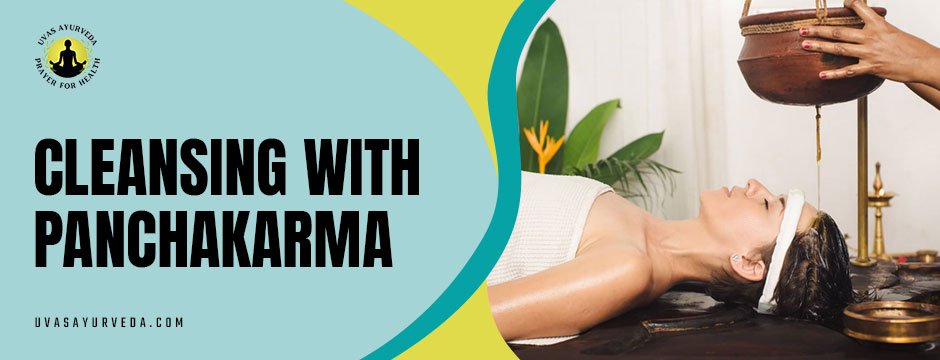Panchakarma is a traditional Ayurvedic detoxification and rejuvenation therapy that aims to purify the body and restore its natural balance. It involves a series of therapeutic procedures designed to remove toxins, promote healing, and enhance overall well-being. Cleansing in Panchakarma is achieved through five main procedures, which are:
Vamana (Therapeutic Emesis): This procedure involves the controlled induction of vomiting to eliminate excess mucus and toxins from the upper respiratory and gastrointestinal tract. It is primarily used to treat diseases related to Kapha dosha imbalances.
Virechana (Therapeutic Purgation): Virechana involves the administration of herbal purgatives to induce controlled bowel movements and eliminate toxins from the liver, gallbladder, and intestines. It is especially beneficial for balancing Pitta dosha and treating various liver disorders.
Basti (Therapeutic Enema): Basti is the administration of medicated herbal oils or decoctions through the rectum. It helps to remove toxins from the colon, nourish the tissues, and balance Vata dosha. Basti is considered one of the most important procedures in Panchakarma.
Nasya (Nasal Administration): Nasya involves the application of medicated oils or herbal preparations into the nostrils. This procedure helps to clear the nasal passages, eliminate toxins from the head and neck region, and balance Kapha and Vata doshas. Nasya is often used in the treatment of respiratory and neurological disorders.
Rakta Mokshana (Bloodletting): Rakta Mokshana is the process of controlled bloodletting to remove impure blood and toxins from the body. It is usually performed in specific cases where there is a predominance of blood-related disorders.
According to Ayurvedic principles, Panchakarma therapies are believed to cleanse the body by removing accumulated toxins (ama) and balancing the doshas (Vata, Pitta, and Kapha). The specific procedures involved in Panchakarma aim to eliminate toxins from various channels, organs, and tissues of the body. By doing so, Panchakarma is thought to enhance the body’s natural detoxification processes and promote overall well-being.
Some studies have suggested its potential benefits. For example, a small study published in the Journal of Alternative and Complementary Medicine in 2002 found that Panchakarma therapies led to significant reductions in lipid peroxide levels (a marker of oxidative stress) and improvements in various health parameters in healthy individuals. Another study published in the Journal of Ayurveda and Integrative Medicine in 2011 reported positive effects of Panchakarma on cardiovascular risk factors.
However, it is important to note that the scientific evidence supporting CLEANSING WITH PANCHAKARMA effects is still evolving, and more research is needed to establish its efficacy. Additionally, the individual experience and results may vary depending on various factors such as the person’s health condition, the expertise of the practitioner, and the adherence to post-treatment guidelines.

It’s also worth mentioning that Panchakarma is a holistic therapy that encompasses more than just physical cleansing. It is believed to have a profound impact on mental, emotional, and spiritual well-being as well. The therapies and practices involved in Panchakarma are designed to harmonize the body, mind, and consciousness.
Panchakarma therapy is one of the most effective methods used in Ayurveda for weight management. The treatment focus on removing the toxins in the body. As a result, removing toxins entails losing the poisonous weight and restoring the body’s natural ability to maintain optimal weight.
Panchakarma promotes a healthy and balanced lifestyle. It includes eating a well-balanced diet, doing yoga and meditation, getting enough sleep, and changing bad eating habits. Including it in our everyday routine is a fantastic approach to expressing gratitude to our bodies.
The therapy improves the operation of the body, allowing us to live a healthier life. Panchakarma also enhances the body’s natural healing abilities to be restored. The Ayurvedic method focuses on purifying the body at different levels and stages and emulates the toxins and increases the digestive fire.
Before undergoing Panchakarma, an individual’s condition is assessed by an Ayurvedic practitioner to determine the most appropriate procedures based on their dosha imbalances and specific health concerns. The therapy is typically carried out in a specialized Ayurvedic center under the guidance of trained therapists and is customized to meet the individual’s needs. It is important to note that Panchakarma should only be done under the supervision of a qualified Ayurvedic practitioner to ensure its safe and effective implementation.
From all the above factors it is understood that the panchakarma therapies really helps to eliminate the toxins from both mind and body and helps to gain the natural health of an individual. It is not a magical action but it is gained through the proper maintenance of daily regimen, seasonal regimen, diet and lifestyle along with the effective Panchakarma treatments. As the literature says ,”this maintains the health of a healthy person and cures the diseased”.


Leave A Comment